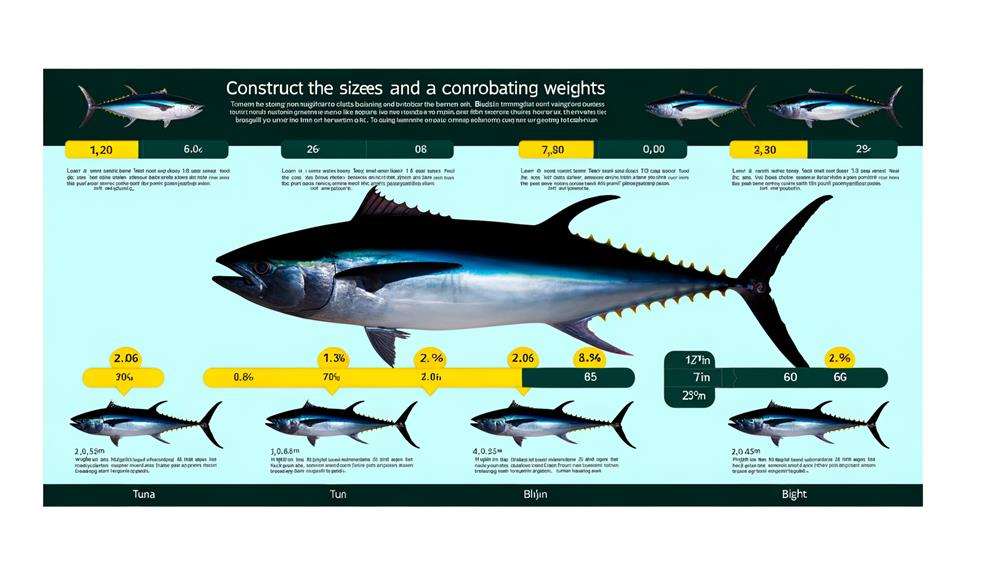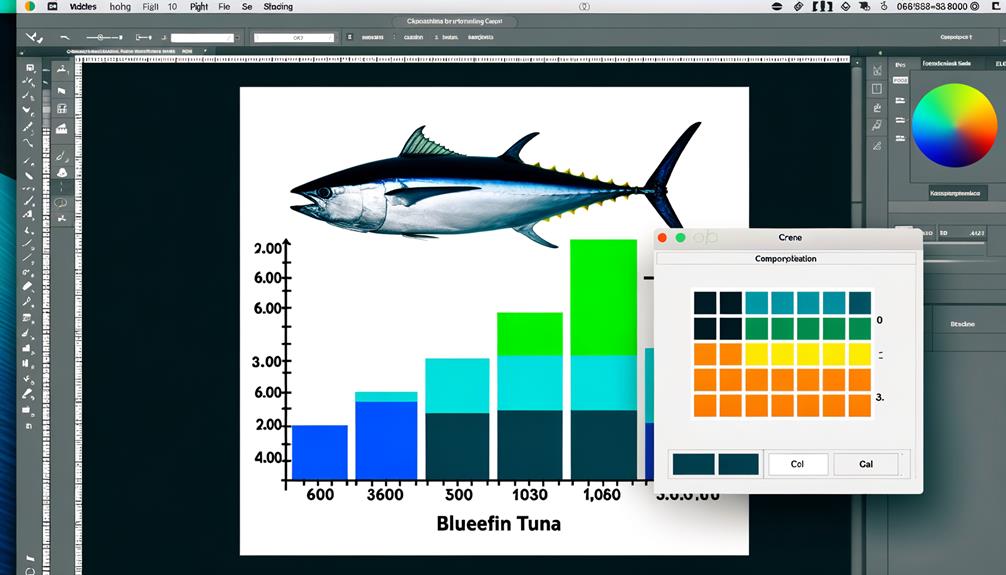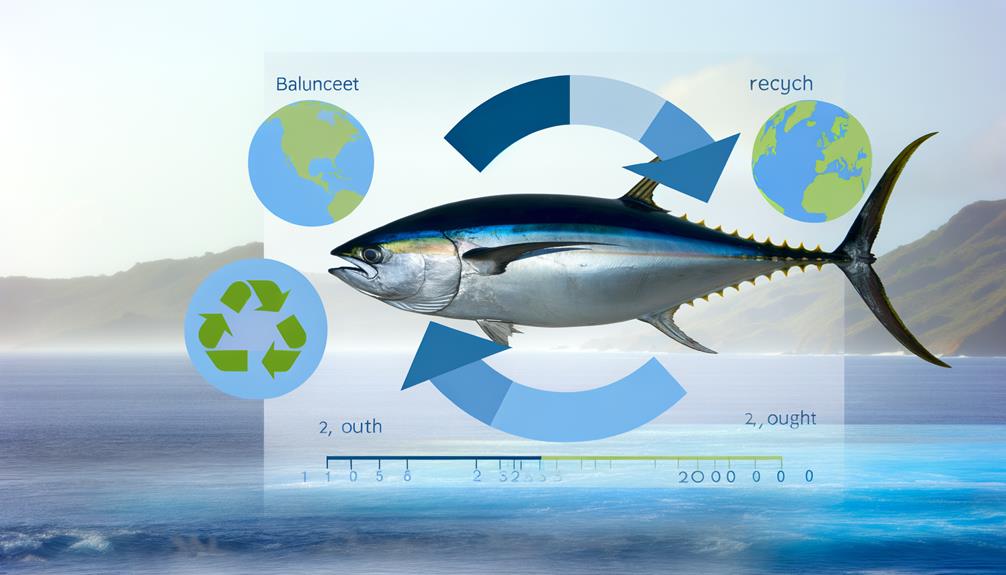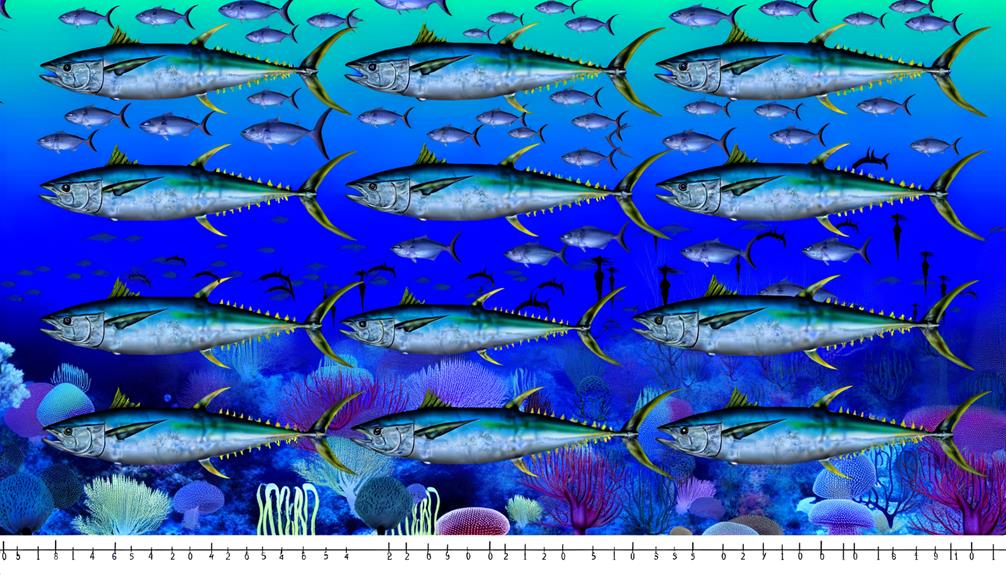Bluefin Tuna Length to Weight Chart
You’re a commercial fisherman and you just caught a big Atlantic bluefin tuna. You quickly measure its curved fork length and reference the Bluefin Tuna Length to Weight Chart to estimate its weight.
The Atlantic bluefin tuna, found primarily in the Atlantic Ocean, is known for its significant size and is a prized catch among commercial fishermen. These big fish are considered the ultimate targets for anglers due to their impressive size and the thrill involved in battling these formidable creatures.
This is more than just a useful tool for fishermen; it’s an essential part of sustainable fishing and the management and conservation of this incredible species.
Curious? Well, there’s more to this chart and its role in saving the Atlantic bluefin tuna. Stay tuned.
Quick Facts
- Curved fork length is the measurement used to classify an Atlantic bluefin tuna.
- Accurate curved fork length measurements are required for regulatory and fisheries management purposes.
- The round weight of a tuna can be estimated from its curved fork length, different for each size class.
- Knowing the length-weight relationship is important for commercial fishing and Atlantic bluefin tuna reproductive capacity.
- The Atlantic bluefin tuna is one of the largest species of tuna, highlighting the diversity within the Thunnini tribe.
Bluefin Tuna Size

To determine the size of an Atlantic bluefin tuna you will measure its curved fork length, a method where you touch specific points on the tuna with a measuring tape. This is the method used for size classification in Atlantic tunas. The tape touches the specific points and measures from the tip of the fish’s snout to the fork of the tail. They will feel the human connection when they are on the line no matter how many inches they are 🙂
Knowing the different size classes, including the additional regulatory size classes for Atlantic bluefin tuna is important. Compliance with fishing regulations is key to maintaining tuna populations and fair fishing practices. The Atlantic bluefin tuna can reach a maximum weight of over 1,500 pounds, significantly larger than the yellowfin tuna, which typically maxes out around 400 pounds.
Another thing to consider is the round weight of the tuna. This can be estimated from its curved fork length, which varies per size class. The length-weight relationship is not always linear but this is a reasonable approximation to gauge the size of the tuna.
Length to Weight Ratio
Now that you know the importance of curved fork length and regulatory size classes, let’s break down the length-to-weight ratio and how it’s used to estimate the round weight of an Atlantic bluefin tuna.
Knowing the length-to-weight ratio is part of fisheries management where you can estimate the weight of a tuna from its length which in turn supports sustainable fishing. Here’s how:
- The length-to-weight ratio is the comparison of the tuna’s length and weight.
- Curved fork length, the measurement used to classify a tuna, is compared to its estimated round weight.
- Round weight varies per size class. For instance, bigeye tuna, which is another species, typically has a different weight characteristic compared to the Atlantic bluefin tuna.
Tuna Measurements Matter
You need to understand the importance of tuna measurements.
Accurate measurement of a tuna’s curved fork length is data for regulatory and commercial purposes which affects conservation. Accurate measurements are crucial for sustainable tuna fishing practices, ensuring that fishing methods like pole and line or trolling are employed responsibly.
You know these facts help scientific studies, compliance with fishing regulations, and sustainable tuna populations.
Importance of Measurements
Measuring the curved fork length of an Atlantic tuna is not just a technicality but a crucial step to determining the size class for regulatory purposes and compliance with fishing regulations. The measurements help to manage the fishery and sustain tuna populations. Size-based regulations are particularly important for managing targeted tuna populations, such as Yellowfin tuna, which sees significant catch volumes globally.
Consider this:
- Round weight estimation: By measuring length you can estimate the weight value and marketability of the tuna.
- Regulatory compliance: Knowing the size classes for Atlantic bluefin tuna based on length is compliance with fishing regulations.
- Preservation and sustainability: Size restrictions based on length and weight preserve the tuna’s reproductive capacity and fair and sustainable fishing.
In short, measurements matter.
Tuna Conservation Impact
In the bigger picture of tuna conservation, your ability to measure the length and weight of an Atlantic bluefin tuna accurately plays a big role in preserving its reproductive capacity and sustainable fishing. This accuracy affects tuna conservation by informing fishery management and enforcement of size limits. Accurate measurements are also crucial for the conservation efforts of southern bluefin tuna, which face threats from overfishing and require careful management to prevent extinction.
By measuring an Atlantic bluefin tuna you’re not only complying with regulations but also contributing to the long-term survival of the species. Remember, each measurement is for regulatory and commercial purposes.
As you grab your rod, think of the big role you play in tuna conservation because each Atlantic bluefin tuna you measure accurately helps sustain tuna populations for future generations.
Scientific Studies and Results
The science behind tuna measurements, your next catch’s size and weight, is key to fishery management, sustainable fishing, and tuna stock preservation.
Scientific committees around the world are looking at this data:
- Accurate measurements mean fair and sustainable fishing which is key to tuna species longevity.
- Size determination is for regulatory compliance.
- Knowing size classes helps sustain populations.
Weight estimates from length are for commercial fishing. This is the value and marketability of your catch.
Studies show the relationship between tuna size and age. This gives us information on their growth and life cycle and helps in management strategies. Additionally, studying other species of tuna is crucial for comprehensive fishery management, as it highlights differences in behavior and ecological relationships.
Bluefin Tuna Size Chart

Measuring Atlantic bluefin tuna you’ll find that curved fork length is the measurement used for regulatory size classes and round weight is estimated from this length and varies per size class. This classification is critical for fair and sustainable fishing.
When charting bluefin tuna growth, remember there are additional size classes for Atlantic bluefin tuna. These may use different measurements and classifications. The same process for Pacific bluefin tuna, length, and weight are the key to determining the size class. Bluefin tuna in the Pacific Ocean may exhibit different growth patterns compared to those in the Atlantic.
Knowing how to convert length to weight in tuna is crucial as it directly affects tuna stock conservation. Lengths and weights-at-age of bluefin tuna are derived from growth rate information. By looking at the relationship between size and age you’ll have a better understanding of the tuna’s growth stages. In this way, you’re not just a spectator but part of the community that’s helping to preserve these magnificent animals. With each measurement, you help chart bluefin tuna growth, a vital task for their survival.
Fishing Healthy Bluefin Tuna
You need to know Bluefin Tuna’s feeding habits to catch healthy ones. The presence of small fish in the ecosystem supports the growth of larger bluefin tuna, as these smaller species can indicate a healthy environment that nurtures the development of bigger fish.
Remember, proper catch and release methods not only save the fish but also the species.
Bluefin Tuna Feeding Habits
To catch a healthy bluefin tuna, you need to know their specific feeding habits which are mostly squids and various fish species. Intake of these prey affects the tuna’s fat content which is a key factor in their health and growth. In comparison, light tuna, such as canned light tuna, has a different nutritional profile with lower fat content and varying levels of protein and mercury.
Here’s a quick rundown of their feeding habits:
- Mostly they eat:
- Squids: Provides protein and fats.
- Various Fish Species: Small to medium-sized fish provide nutrients and maintain fat content.
- Other marine species: Occasionally they eat crustaceans and eels to supplement their diet.
Now you know you’re fishing for healthy and fed bluefin tuna. Remember understanding their feeding habits is not just for a good catch but for the species too.
Catch and Release
Now that we know bluefin tuna’s feeding habits, let’s talk about how to catch them in a responsible way that promotes their survival and health after release.
One of these is choosing the right fishing gear. Barbless hooks for instance minimize damage and make hook removal easy.
Always keep the tuna in water during unhooking and limit handling time to reduce stress. Handle the pectoral fins carefully to avoid causing additional stress to the fish.
Reviving the fish is part of the release process. By holding the tuna upright in the water and gently moving it back and forth you can help restore its strength.
Knowing and following these catch-and-release practices is vital for healthy bluefin tuna populations.
Conservation Implications

Knowing how to determine the size of Bluefin tuna is key to fisheries management, preserving the reproductive capacity of the species and the long-term sustainability of tuna fisheries. This is key to understanding the conservation implications of the Bluefin Tuna Length to Weight Chart. Conservation efforts in the eastern Pacific Ocean have shown significant positive impacts on tuna populations, highlighting the importance of regional initiatives.
To put it in perspective:
- Compliance with size limits is important for sustainable tuna populations and fair fishing practices. It’s not just about catch numbers it’s about the size of the catch too.
- Size-based regulations: These conserve tuna stocks. By following these rules you’re directly helping the survival of the species.
- Monitoring and enforcement: Accurate size classification is fair and sustainable. Without proper enforcement, regulations are just words on paper.
In short, by following these guidelines you’re not only maintaining the health and reproductive capacity of Bluefin tuna but also the long-term viability of the industry. By knowing the importance of size determination you’re part of the conservation effort.
The Bluefin Tuna Length to Weight Chart
Now let’s get into the specifics of the Bluefin Tuna Length-Weight Chart. The curved fork length measured from the tip of the upper jaw to the fork of the tail is the key to a tuna’s size class. This length and weight correlation is for commercial fishing purposes and regulation compliance as it gives an estimate of the tuna’s round weight.
The length-weight chart is also crucial for determining the marketability of different tuna species, including canned tuna, which holds significant commercial value. Knowing this length-weight relationship is key to preserving the reproductive capacity of these magnificent creatures. It’s for fair and sustainable fishing practices and the conservation of tuna stocks. The exact size determination this chart provides is vital for fisheries management.
Plus 78.6% of the population has a size-age correlation. This is important in evaluating the fishery resource and potential impacts, so you can shape your fishing strategies and conservation efforts. So you’re not just using a chart, you’re helping to a sustainable future for Bluefin Tuna.
Beyond Size: Bluefin Tuna Facts

While you know the size of the Bluefin Tuna, it’s also important to know other interesting facts about these marine animals. The size in the bluefin tuna length-to-weight chart is just the surface.
Beyond the size consider these:
- Speed and Endurance
- Bluefin tuna are built for speed and endurance and can reach up to 43 mph.
- Their bodies are streamlined for movement, with powerful muscles.
- Migration and Lifespan
- They migrate across oceans.
- Some live up to 40 years, that’s how resilient and adaptable they are.
- Ecological and Economic Importance
- Bluefin tuna is a key player in the marine ecosystem and regulates prey populations.
- They’re also valuable for commercial fishing and contribute to the economy.
Additionally, various species of tuna fish, such as yellowfin and albacore, have unique characteristics that distinguish them from bluefin tuna.
FAQ
How big is a Pacific Bluefin Tuna in Length to Weight?
You’re asking about the size of Pacific bluefin tuna. On average they’re 1.5 meters long and 60 kg. This can vary depending on diet and environment. These tuna are found in the Pacific Ocean.
How old is a 200 Lb Bluefin Tuna? (Tuna Age Size Chart)
You’re looking into the life of a bluefin tuna. A 200 Lb bluefin is like a fine wine, 10-12 years old. That’s a small slice of their 40-year life. In comparison, a southern bluefin tuna of similar weight is typically younger, often around 8-10 years old, highlighting differences in growth rates between species.
How much is a 6 Foot Tuna?
You’re asking how much is a 6-foot tuna. Well, it’s not just about length. Diet is a big factor. A healthy, well-fed bluefin can weigh around 600 pounds. Health and nutrition matters! A 6-foot tuna is considered a big fish, making it an ultimate target for anglers due to its impressive size and the thrill of the catch.
How do you calculate the weight of a Bluefin Tuna?
To calculate a bluefin tuna’s weight you’ll measure its curved fork length. Then you’ll refer to a length-weight conversion chart. It’s important for tuna conservation, for sustainable and responsible fishing practices. Accurate weight calculations are crucial in sustainable tuna fishing to ensure that fishing practices do not negatively impact tuna populations.
Conclusion
Now you see the bluefin tuna’s size, their growth charted, their health assessed and their conservation implications considered.
You’ve used the length-weight chart, gone beyond the size to tuna facts, and seen the importance of exact measurements in fisheries management. Accurate measurements are also crucial for managing targeted tuna populations, particularly Yellowfin tuna, which sees significant catch volumes globally.
So as you reel in your knowledge you’re a key player in the bluefin tuna population.
Remember it’s not just about fishing, it’s about science, sustainability, and the future of these amazing sea creatures.
